The City Archaeologist is actively involved in promoting knowledge and appreciation of the history and archaeology of the city. A very successful autumn series has taken place in the City Library since 2015. In addition the City Archaeologist is actively involved with local historical societies.
The 3rd and final lecture, in the Autumn Archaeology lecture series, Digging for Cork: Urban Excavations, will take place on Tuesday 29th November at 7pm in the City Library, Grand Parade.
The lecture, on Recent Excavations on North Main Street Cork, will be given by Avril Purcell, Consultant Archaeologist with Lane Purcell Archaeology.
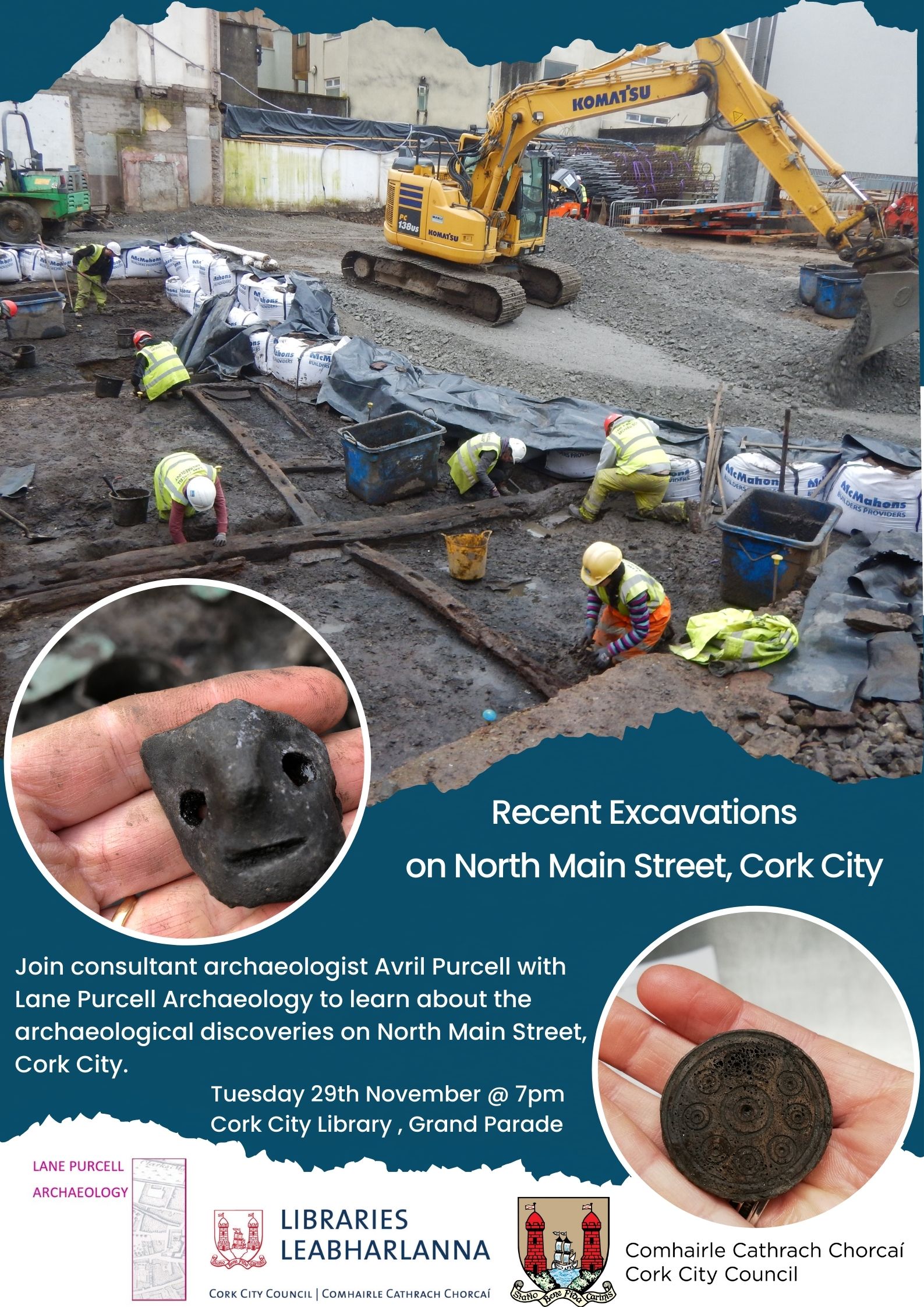
The 2nd lecture in the series Digging for Cork -Urban Excavations takes place on Tuesday, 25th October at 7pm in the City Library, Grand Parade. The lecture will also be live-streamed https://www.corkcity.ie/en/tv/
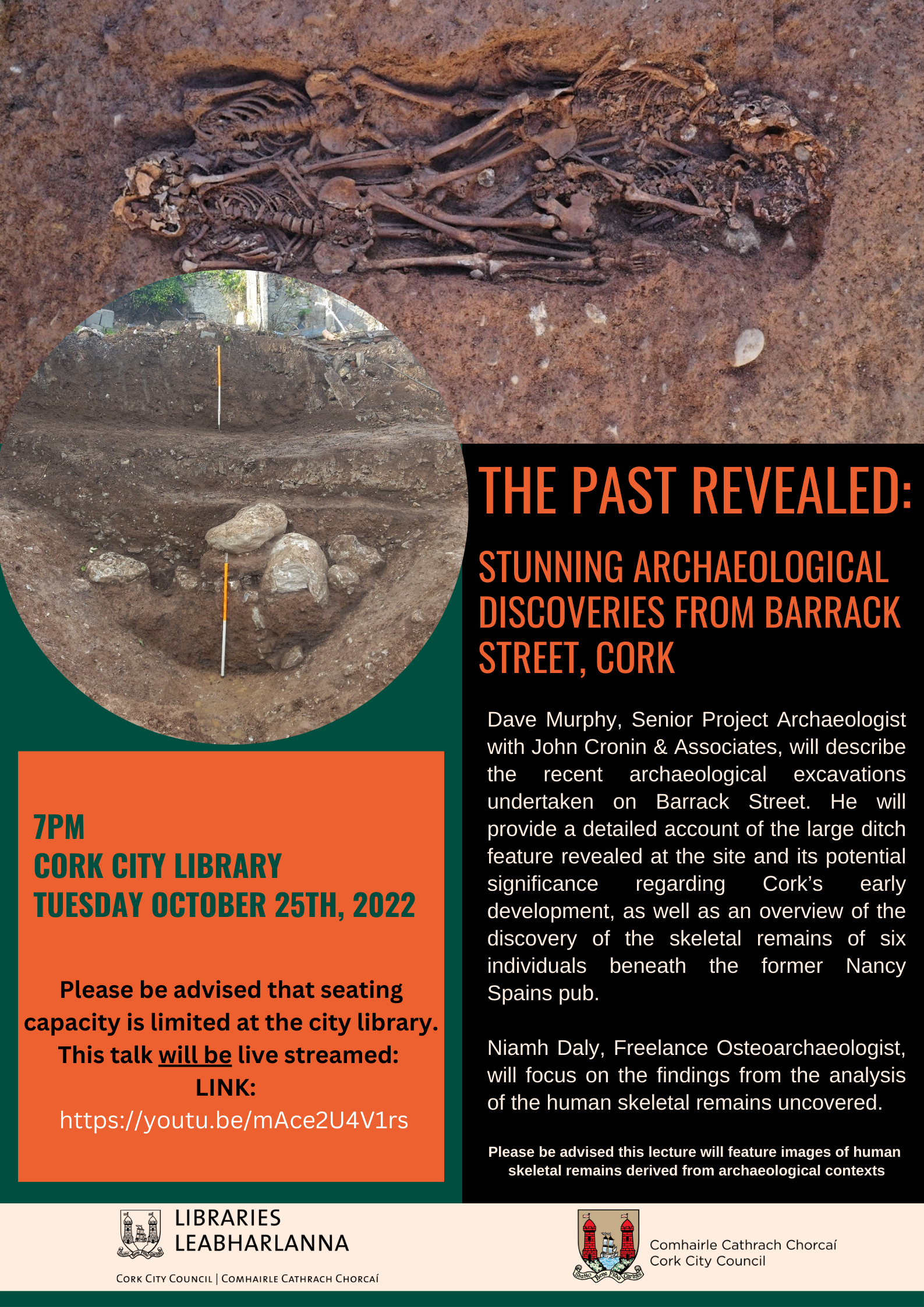
2022 marks the 8th Annual Archaeology Lecture Series and we return to in-person presentations in the City Library, Grand Parade, Cork. The series Digging for Cork-Urban Excavations will feature recent discoveries at Barrack Street and North Main Street. The first lecture, by Ciara Brett, City Archaeologist will take place on the 27th September at 7pm.
.jpg)
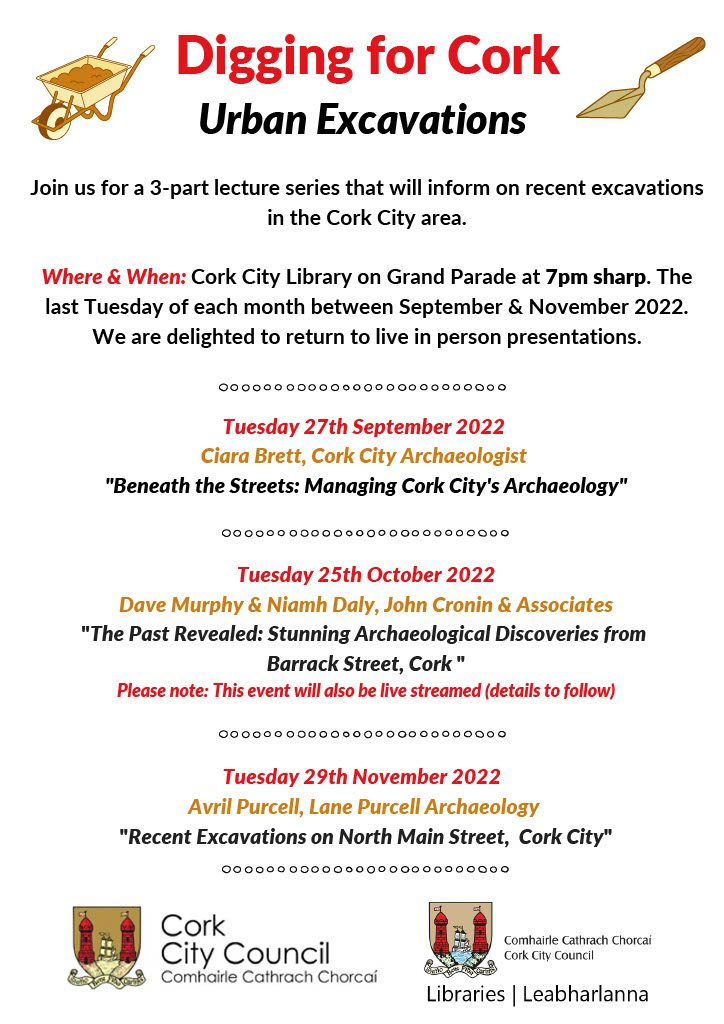
This year marks the 7th Annual Autumn Archaeology Series. Following on from 2020, we will continue the lecture series on-line.
The Autumn series for 2021 is titled Urban Boundaries: Know Your Monuments. Each month from September to November we will share information on various archaeological monuments and features in the City -- from prehistoric fultacht fiadh to 19th century icehouses.
The series will take the form of pre-recorded presentations given by guest speakers and the City Archaeologist. As always, we will run the book competition, but this year like everything, in a slightly different way. At the end of each presentation there will be a question relating to Cork’s Urban Heritage. Answers are to be emailed to archaeology@corkcity.ie. The books are kindly provided by Cork City Library.
The final part of the three-part series titled Urban Boundaries: Know your Monuments focuses on prehistoric Fulacht Fiadh and Ice Houses.
Fulacht Fiadh are prehistoric cooking sites and Icehouses were used in the 18th and 19th century to store ice used in the preservation of food.
Niamh Daly will discuss Fulacht Fiadh and Ciara Brett, City Archaeologist will present on Ice Houses.
To be in with a chance to win Cork Strolls – Exploring Cork’s Architectural Treasures by Gregory and Audrey Bracken
answer the question below and email the correct answer to archaeology@corkcity.ie by 1st of December.
October Winner: Marian Cusack
Name two common features of a Fulacht Fiadh (Answer is in the presentation!!)
This edition of the Know your Monuments Series will focus on Ringforts and Standing Stones.
Ringforts is presented by Ciara Brett, City Archaeologist and Standing Stones by Niamh Daly.
October Book Competition:
To be in with a chance to win a copy of Secret Cork by Kieran McCarthy answer the question below and email the correct answer to archaeology@corkcity.ie by 12th November.
September winner is: Patrick O’ Connell
What size is the Garryduff Bird? (Answer is in the presentation!!)
Amanda Clarke curates a website Holy Wells of Kerry and Cork. Amanda has studied over 300 holy wells in Cork and in this presentation below will give an overview of their type and function.
September Book Competition Question:
To be in with a chance to win a copy of Wells, Graves, and Statues: Exploring the heritage and culture of pilgrimage in medieval and modern Cork city by Louise Nugent and Richard Scrivens, answer the question below and email the correct answer to: archaeology@corkcity.ie by 15th October.
On what day is St Finbar, the patron saint of Cork, celebrated? (Clue: Answer is in the presentation!!)
This year marks the sixth Annual Archaeology Lecture Series. We normally launch the Autumn Archaeology Series of Illustrated talks during Heritage Week and it continues to run one evening a month until November. Adapting to an online format this year, the theme for the series is as always inspired by the chosen theme for Heritage Week and so is titled Knowledge Sharing: Cork’s Urban Heritage this year.
The focus of the Autumn series is to focus, highlight and share the archaeology, history, and heritage of urban Cork to the local community. We hope you enjoy this online series for 2020 and with a similar sentiment in the words of the late local Cork historian Ronnie Herlihy:
”I was hoping to awaken in people, no matter where they live, an awareness of their own surroundings, and to get them thinking of the fantastic history all around them that has led to the making of this great City of Cork” (Herlihy, 2010, A Walk Through the South Parish: Where Cork Began, pg-iv).
The series will be presented in a multitude of formats including online lectures, podcasts, historical information, links to resources, photographs, recommended reading, shared memories and related tales or questions regarding urban Cork’s historic past. The four online events will take place each month from August to November.
In the first edition titled Heritage and Education we will look at some of the connections between heritage and education in Cork city. We start by looking at the wonderful educational resources available through the Heritage Council, who organise and co-ordinate Heritage Week activities nationwide. We outline the fantastic heritage projects running in Cork City this Heritage Week.
Focusing then on the city of Cork we look at University College Cork, the Ogham Stone Corridor and St Finbarr. We move on then to the history of the cities Library service with guest contributor Helen McGonagle, Executive Librarian Music, at Cork City Library on Grand Parade. Nano Nagle is next to feature and her important role of setting up local schools to education the poor in medieval Cork. Moving from education in medieval Cork to the present-day Cllr. Kieran McCarthy, guest contributor, outlines the Discover Cork: Schools’ Heritage Project which has been successfully running in Cork for eighteen years. Finally, we look at the Cork Public Museum and how the archaeological artefacts on display teach us about past lives spanning from the evidence from the Mesolithic up to medieval Cork. We finish then with a selected bibliography of further reading on the various subjects and interesting links to aid you with future research.
The Heritage Council
In 1995, the Heritage Council was established under the Heritage Act 1995 as a statutory body, to foster an integrated approach to Ireland’s national heritage. The Heritage Council head office is located in Kilkenny town, housed in the beautiful Georgian building, Áras na hOidhreachta since 2008. The role of the Heritage Council is to give policy advice, educate, raise awareness and work with local communities/groups and partners to promote our national heritage which complements and builds on the work of other state heritage bodies. Heritage Plan Projects for 2020 awarded to Cork City Council include the Cork Heritage Open Day.
The Heritage Council also runs the Heritage in Schools Scheme where heritage specialists can come to a school to educate about the tangible, intangible and natural heritage of Ireland. This year marks the 15th annual celebration of National Heritage Week, a week usually packed with over 2000 heritage events nationwide, however, owing to COVID 19, like our local Urban Cork heritage series, events and activities are based online or by project submission for this year. Heritage Week is a wonderful initiative by the Heritage Council and this year’s theme is titled – ‘Heritage and Education: Learning from our Heritage’.
Some of the heritage events taking place in and around Cork City this Heritage week are listed below so we hope you enjoy what Cork has to offer this year.

Photo credit: The Heritage Council
A brief History of Cork City Library by Helen McGonagle
Cork was the first Irish city to adopt the Public Libraries (Ireland) act of 1855, which allowed municipal councils to establish a library and charge an annual rate of a maximum of one penny on city businesses to support it. However difficult financial circumstances meant that a library service was not opened until December 1892, in what is now the Crawford Municipal Art Gallery.
Application was made in October 1901 to Andrew Carnegie by the then Lord Mayor, Edward Fitzgerald, for a donation ‘with a view to establishing a free public library for the great and important City of Cork.’
£10,000 was gifted to the people of Cork by Mr. Carnegie in August 1902 for the purpose of building a new free library in the city. The official opening took place on September 12th, 1905, at 2.30 pm and was conducted by the Lord Mayor, Alderman Joseph Barrett.
This building lasted for only 15 years, until 1920, when it and its contents were destroyed by fire, along with City Hall and much of the city centre by British Crown Forces. The burning of the Carnegie Library left the city without a public library service until 1924, when premises were provided on a temporary basis on Tuckey Street. That service transferred in 1930 to its current location at 57-58 Grand Parade.
For its first eighty years, Cork City Library operated from just one location Grand Parade. The 1970s saw the beginning of more library development.
Helen has been busy with her team in the City Library and has created a fantastic online project that forms part of the Heritage Week festivities. The project is titles: Borrowed Space to Cyper Space and can be viewed on the Heritage Council website.
Check out the website for further details: https://www.corkcitylibraries.ie/en/
DID YOU KNOW? An online service of Cork City Libraries includes “Cork Past and Present” where you can learn and view the old maps, photos, prints, genealogies, and cultural life of Cork in days gone by. The library also provides a range of information services including books, learning and research support, children's services, music, 3D printing and internet access.
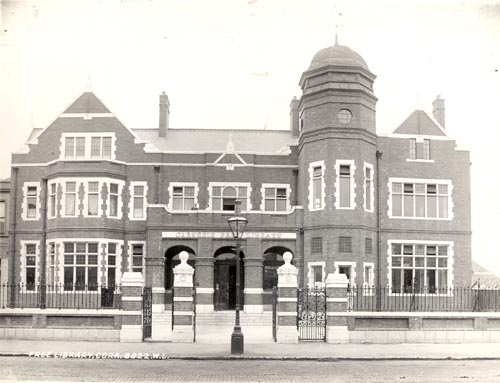
(Photo: Carnegie Library on Anglesea Street from the Lawrence Collection).

Photo courtesy of Cork City Library, Grand Parade
Discover Cork: Schools’ Heritage Project by Kieran McCarthy
Founded in the school year 2002/ 2003, the school year 2020/21 marks the eighteenth year of the Discover Cork: Schools’ Heritage Project. The Project is open to schools in Cork; at primary level to the pupils of fourth, fifth and sixth class and at post-primary from first to sixth years. There are two subcategories within the post primary section, Junior Certificate and Leaving Certificate. A student may enter as an individual or as part of a group or a part of a class entry.
One of the key aims of the project is to allow students to explore, investigate and debate their local heritage in a constructive, active, and fun way. Projects on any aspect of Cork’s rich heritage (built, natural and cultural) can be submitted to an adjudication panel. Prizes are awarded for best projects and certificates are given to each participant.
Through the boundary extension of Cork City in June 2019, it led to the project application brochures being sent to a wider set of schools and a wider youth population. For the 2019/ 2020 school season a total of 26 schools, circa 950 students, 45 teachers in Cork City took part in the Project. Each participating school received a visit and workshop from the co-ordinator from September through to October 2019. A total of 40 hours of workshops were delivered. The workshop comprises an hour of interactive work of how to put together a project. The workshop gives the participants a structure to work towards and brain stormed ideas and potential around their project work.
The project participants are also helped by on average four people. The average engagement within the population of Cork City is approximately 4,000 people. At the end of the almost three-month research period circa 250 projects are submitted on all aspects of Cork’s heritage.
TheDiscover Cork: Schools’ Heritage Project continues to provide the student with a hands-on and interactive activity that is all about learning not only about your local area but also about the process of learning by participating students.
The project is about thinking about, understanding, appreciating, and making relevant in today’s society the role of our heritage – our landmarks, our oral histories, our scenery in our modern world for upcoming citizens. So, the project is about splicing together activity on issues of local history and heritage such as thinking, exploring, observing, discovering, researching, uncovering, revealing, interpreting, and resolving.
The Discover Cork: Schools’ Heritage Project is a youth forum for students to do research and offer their opinions on important decisions being made on their heritage in their locality and how they affect the lives of people locally.
This project is kindly funded by Cork City Council (via the help of Niamh Twomey). Prizes are also provided by the Learnit Lego Project, Lifetime Lab, Lee Road (thanks to Mervyn Horgan, www.lifetimelab.ie), Cllr Kieran McCarthy, and Sean Kelly of Lucky Meadows Equestrian Centre, Watergrasshill, www.seankellyhorse.com.
Saturday 22 August, 13:00-13:30
BRIDGES OF CORK: HERITAGE TREASURE HUNT
Cllr Kieran McCarthy in collaboration with Meitheal Mara & Playful Paradigm
Meet Cllr Kieran McCarthy at National Monument, Grand Parade, Cork, between 1pm-1.30pm, no booking required. Bring a pen.
Suitable for all ages, approx. 2hr walk, mixed footpaths on city’s quays.
On meeting Kieran, he will give you a self-guided walking and heritage treasure hunt trail to follow around the historic bridges of Cork City Centre island. Discover the city’s unique relationship with the River Lee.
On the way your task is to explore the built heritage around the bridges and unlock the answers to the Heritage Treasure Hunt. Those who get all the answers right will be in with a chance to win a copy of Kieran’s new book, Witness to Murder, The Tomás MacCurtain Inquest (with John O’Mahony, Irish Examiner, 2020). Link to his educational blogCork Heritage.
DID YOU KNOW? Cllr Kieran McCarthy will be partaking in two heritage related events this Heritage Week. Make sure to try and catch one (details below). If not, do check out his educational blog about Cork Heritage.
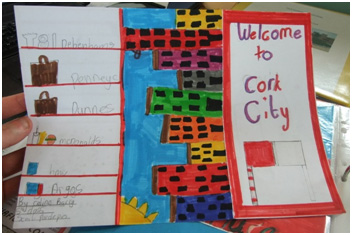
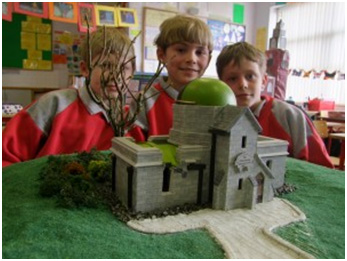
Photos courtesy of Kieran McCarthy
University College Cork
To begin we look to the ceremonial gates of University College Cork on Western Road, built in 1929 and note the college’s crest placed high up on the black gates. The crest reads “Ionad Bairre scoil na muman” which translates as “Where Finbarr thought let Munster learn”. The crest was designed in 1889, comprising of the arms of the City of Cork. Depicted on the crest (see image below) are two castles believed to be the Queen’s and King’s Castle and a large ship entering between the two castles. The royal lion and the three crowns symbolise the ancient sub-divisions of Munster (the Ormond, the Desmond and Thomond) and in the centre of the crest there is the open book of learning.
St Finbarr, Cork’s patron saint, has become synonymous in Cork with many of its sporting, and religious institutions being named after him. Allegedly, St Finbarr founded a monastery and school here in Cork during the early seventh century somewhere between UCC and St Fin Barre’s Cathedral although the precise location has yet to be discovered.
In a recent interview UCC Emeritus Professor Pádraig Ó Riain, (Department of Early and Medieval Irish) explains that “The cult of St Finbarr in Cork had more to do with church politics than historical fact,” and that “Finbarr’s school was located at his church in Movilla near Bangor in the Ards Peninsula in Co Down. What reached Cork was devotion to the saint rather than the man himself”. Professor Ó Riain further explains that "The legend attached to the saint included his reputation as a teacher hence when the third Lateran Council of the Church decreed in 1179 that each cathedral should provide an income to support a school master it was decided to give the new school in Cork a good start by attributing the original founding to St Finbarr, thus lending lustre to the fledgling school”(quotes taken from the Irish Examiner Newspaper Interview, 25th September 2019).
UCC boasts a fine statue of St Finbarr designed by Cork Sculptor Seamus Murphy who casts his shadow over the Aula Maxima in UCC. The saints feast day is celebrated on September 25th. Last year in UCC, harpists Ruth Mc Donnell and UCC alumnus Dr Fiachra Ó Corragáin performed an 'Air to St Finbarr'.
Outside the Aula Maxima in UCC, in the north cloister of the Quadrangle building is the Stone Corridor which is an impressive display of Ogham Stones collected and donated to the university by 19th century antiquarians. Many of the Ogham stones in the stone corridor originate from sites in Co. Cork and are believed to date from the 4th to the 8th centuries AD. This time represents the emergence of Christianity in Ireland. These tall perpendicular stones have inscriptions in the style of horizontal or diagonal lines or notches representing an early form of the Irish language. Believed to be associated with burials the names depicted on the Ogham Stones often represent genealogical affiliations with particular areas. If you would like to learn more about Ogham Stone, Dr Nora White, a previous speaker on the Autumn Archaeology series has an informative podcast on the Amplify Archaeology Podcast series coordinated by Abarta Heritage. These podcasts feature a series of interviews on various themes with an array of archaeologists and specialist from Ireland.
DID YOU KNOW? In UCC in 1934 the statue of Queen Victoria was replaced by the statue of Cork’s patron saint, St. Finbarr. Bizarrely her statue was buried in the president’s garden in UCC and in 1995 to celebrate the 150th anniversary of the college’s foundation she was placed back on permanent display and preserved as a work of art and as a reminder of historical events.
DID YOU KNOW? UCC was constructed during the height of the Irish Famine (1845-1849) and opened on November 7th, 1849. Originally named Queen’s College Cork after Queen Victoria who was present at the opening event. The perpendicular Gothic style was designed by architects Benjamin Woodward and Sir Thomas Dean.
Talking to Stonesby Liz O’Donoghue
Through the coolness of the stone corridor reading ogham into our trite conversation into the quad and sunshine and bodies making ogham lines along the path until our conversation turns to stone. Making a meal of dining out with you flashing your plastic in my face and stammering in my ear – how could you accuse me of playing with your heart as you stuffed your face. ‘Arts as a faculty’ you said ‘is way down the line’ so I took to reading stones in the stillness and compared your mind to a corridor. From gothic windows I saw magic in the mist hanging over the quad and felt the druidic splendour of those stones.
(Hopkin, A. On the banks Cork City Poems and Songs 2016 pg. 305)
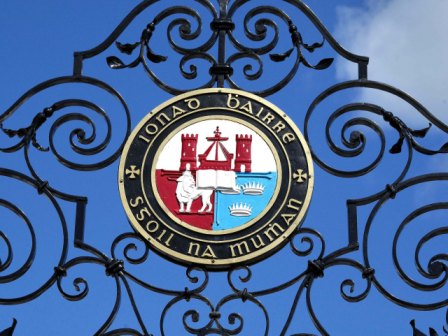
Photo Credit: Tomas Tyner, UCC
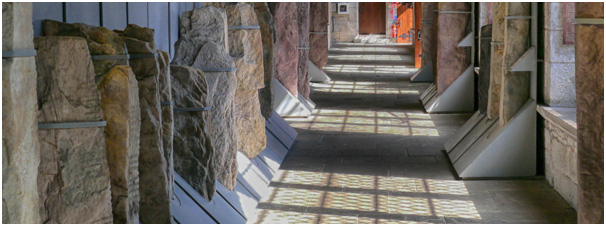
Photo Courtesy of Tomas Tyner, UCC
Nano Nagle
Honora (Nano) Nagle was born in 1717 into a wealthy, well-connected Catholic family in Cork that had managed to retain its lands under the Treaty of Limerick.
Growing up while the penal laws – designed to subdue and diminish Irish Catholic power – were in full force, she was sent to a convent in Europe aged 10 and on completing her education moved to Paris, where she lived among the high society. After spending two years in a French convent, she returned home, her Jesuit confessor having told her it was her duty to instruct Irish children.
Nano Nagle established a school in Cork city, and subsequently six others, in which poor boys and girls from the streets were taught reading and catechism, with the boys also learning to write and the girls learning needlework. It was a steady enough start, ultimately transformed by a large inheritance, but Nagle wanted to establish a convent in Cork to undertake the project. After finding the Ursuline order was not fit for her purpose, Nagle wore down the opposition of the Bishop of Cork and established her own order in 1785, which eventually became known as the Presentation Sisters. In this she was “the first Irish woman to find a congregation on the island since St Brigid” (Info from Newspaper article).
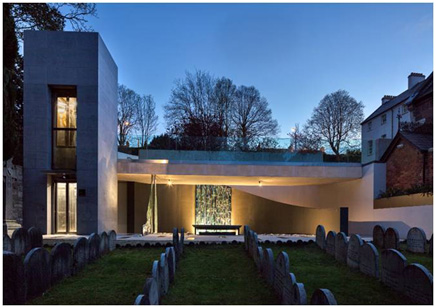
Nano Nagle’s Tomb at Nano Nagle Place (Photo Credit: Nano Nagle Place)
Take a visit to the former South Presentation Convent at Nano Nagle Place on Douglas Street and experience what life would have been like in the 18th century Cork.
https://nanonagleplace.clr.events/event/129875:nano-nagle-place-general-admissions
Cork Public Museum
Cork Public Museum is the oldest local authority museum in Ireland, celebrating its 75th anniversary in 2020.
The museum is housed in two buildings: a mid-nineteenth century Georgian style house, and a modern extension that was opened in 2005. The two storey Georgian house commands a central position in Fitzgerald Park, Cork. Originally built in 1845 by the Beamish family, the building, then known as The Shrubbery, was their family home for decades. The property and surrounding land was eventually purchased by Cork Corporation for the purpose of housing the Cork International Exhibition of 1902 and 1903. The site of the exhibition was opened as Public Park in 1906.
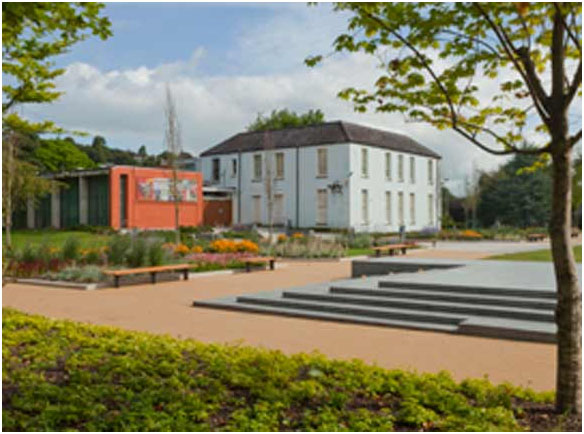
Since opening in 1945, Cork Public Museum has actively collected, exhibited and cared for a wide range of objects related to Cork’s diverse historical heritage. The present collection is made up of about 40,000 objects covering a variety of subjects from archaeology and natural sciences, to the political, cultural and social history of Cork city and county. In addition to the accessioned material, Cork Public Museum currently has loans from institutions such as UCC, the National Museum of Ireland and many other private individuals. Approximately 9-10% of the collection is currently on long-term loan from other institutions or individuals.
Visit www.corkpublicmuseum.ie for more details.
If you would like to find out more about the role of an archaeologist, Rubicon Heritage based in Midleton, Co. Cork have a very informative webinar series on YouTube “Introduction to Archaeology” which covers topics such as the legal framework, the planning process, methods and practices and archaeology in the construction industry.
Many thanks for visiting the first online series titled “Education and Heritage” where we featured a selection of interesting sites around urban Cork. We leave you with a recommended short walk titled University Walk- A self-guided walking tour of the University area of Cork City.
Don’t forget to connect to the second talk in the series Heritage on your Doorstep on Tuesday September 22nd.
If you would like to contribute to the next online series please do email archaeology@corkcity.ie.
Raffle Question: To be in with a chance to win a copy ofNano Nagle: the life and the legacy by Deirdre Raftery with Catriona Delaney and Catherine Nowlan-Roebuck and A Room of Their Own – Cork Carnegie Free Library and its Ladies Reading Room by Helen McGonagle (signed copy) answer the question below and email your answer to archaeology@corkcity.ie by 1st September 2020.
The winner will be notified by email and the book will be sent by post.
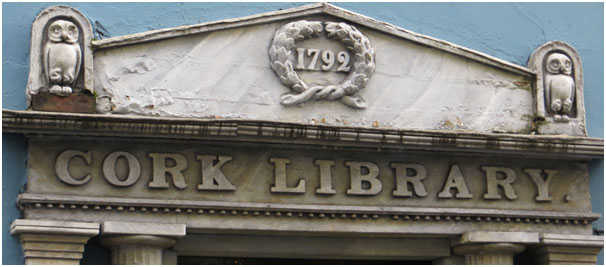
(Photo courtesy ofhttps://readingthesigns.weebly.com/)
Question 1: Can you tell us the location of this sign? Please name the street.
Selected Bibliography
Useful webpages for the archaeology and heritage of Cork:
https://www.corkcity.ie/en/council-services/services/arts-culture-heritage/archaeology/
http://www.corkpastandpresent.ie/
St Finbarr:
http://liminalentwinings.com/tag/ladys-well/
https://www.youtube.com/watch?v=7UVBDl6ytD0
https://roaringwaterjournal.com/2015/10/11/william-burges-and-saint-fin-barres/
https://roaringwaterjournal.com/2020/05/24/to-puncture-the-mysterious-finbarr-and-the-serpent/
https://roaringwaterjournal.com/2015/03/28/corks-rebel-daughter/
Local publications available at Cork City libraries
Cadogan, T. 2003. Cork in Old Photographs. Gill and Macmillan.
Fitzpatrick, J. E. 2005. A city of Surprises: Hidden Treasures of Cork’s Northside. Cork: Fitzpatrick Press
Herlihy, R. 2010. A Walk Through the South Parish: Where Cork Began. Cork: Lee Press.
Hopkin, A. 2016. On the Banks Cork City in Poems and Songs. Cork: Collins Press
McCarthy, K. 2019. Cork City: History Tour Great Britain: Amberly Publishing.
McGonagle, H. 2015. A Room of Their Own – Cork Carnegie Free Library and its Ladies Reading Room. Cork: Cork City Library.
McManus, D. 2004. The Ogham Stones at University College Cork. Cork:Cork University Press
Mullins, J. and Ronayne, L. 2005. A Grand Parade: Memories of Cork City Libraries: 1855-2005. Cork: Cork City Council.
Murphy, J. A. 1995. ‘The College: A History of Queen’s/University College Cork’ Cork: Cork University Press.
O’Callaghan, A.2010. Cork’s St Patrick’s Street. Cork: Collins Press.
The 5th Annual Autumn Archaeology Lecture Series
Small Things Remembered: Cork’s Artefacts is the 5th Autumn Archaeology Lecture Series to take place in the City Library, Grand Parade. The opening lecture took place on Tuesday, 20th August 2019 during Heritage Week.
Please see the programme below for details.
Welcome to the second part of the online series Knowledge Sharing: Cork’s Urban Heritage. In this edition we focus on the theme of Heritage on your doorstep and highlight sites of interest around the urban landscape of Cork City. So, this month as autumn approaches, head into the city and take a walking trail and explore the urban sites of Cork’s built heritage and archaeology.
In the presentation here we learn about some of the unusual sites and features in the urban city centre. Remember to look up and around when you are strolling around as very often the most interesting heritage can be the most ordinary item from the past, such as a wheel guard at an entrance to a building or a feature on a window or door frame.
See below some useful links to the visitor attractions in the city. Also included are guides to four city centre walking trails.
https://www.corkcity.ie/en/things-to-do/attractions/
https://www.corkcity.ie/en/things-to-do/parks-outdoors/cork-city-walks/
Select Bibliography:
Bracken, G & A. 2018. Cork Strolls: Exploring Cork’s Architectural Treasures. The Collins Press: Cork
McCarthy, K. 2016. Cork City History Tour. Amberly Publishing: UK.
O’ Callaghan, A. 2019. Read All About It Sculptures & Monuments in Cork City-An Illustrated Exploration. Cork City Libraries: Cork.
Book Competition
We are delighted to announce the winners of the August book competition:
August Answer: Pembroke Street
September Question:
Can you name the street where this architectural feature (Hint: Fireplace surround and not in its original location!) is located?
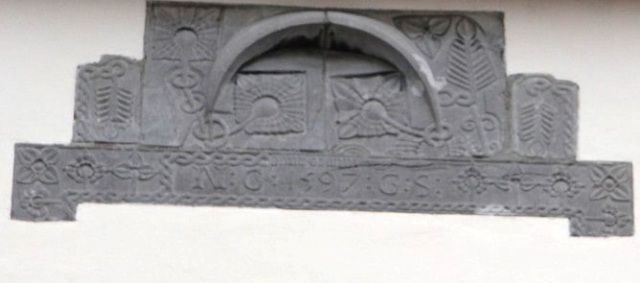
Answers are to be emailed to archaeology@corkcity.ie by 16th October. The winner will receive Read all about it; Sculptures & Monuments in Cork City – An Illustrated Exploration by Antóin O Callaghan
Check in to the next instalment in our series on 27th October when Ciara Brett, City Archaeologist, will give a presentation on Cork City’s Burial Places.
Welcome to the third part of the online series Knowledge Sharing: Cork’s Urban Heritage. In this edition we focus on the theme of Cork City’s Burial Places.
Cork City is one of the oldest cities in Ireland and has a rich archaeological heritage. The continuous occupation of Cork City for over 1400 years spans many changes in religious doctrine, interpretation, ecclesiastical organisation and ritual as well as associated burial practices and traditions. In the presentation here Ciara Brett, City Archaeologist, will examine the origins and development of burial grounds in the city and will introduce the various types of burial places in the city using some case studies to illustrate the archaeological discoveries uncovered at some sites.
Cork City’s Burial Places (2011) Research by H. Kelleher and F. McCarthy (Editor: C. Brett) This book examines the origins and development of burial grounds in the city. They vary from churchyards, churches containing vaults, private burial grounds of religious houses and the military, stray find spots of skeletal remains large modern cemeteries.
Did you know?
Stones from the ruins of Shandon Castle were used for the building of St. Anne’s Shandon.
Did you know?
The kink in the spire of Trinity Presbyterian Church is said to have been made deliberately by disgruntled workers in a wage dispute. Although a nice (or perhaps not such a nice) story, it is probably simply the result of bad workmanship, a pity on such a beautiful building.
Did you know?
John Hogan, one of Ireland’s most important nineteenth-century sculpture, selected the marble he used for the Dead Christ in St Finbarr’s Church from the same quarry in Carrara, Italy that Michelangelo used.
Did you know?
The organ of St Fin barre’s Cathedral was originally located over the central entrance but is now under the chancel floor, making it the only underground church organ in the world.
Did you know?
Triskel Christchurch’s organ was a gift to the church from Sir Francis Drake. He found it among the treasure seized from a Spanish galleon. Intended as a gift for the King of Spain to the people of Mexico, it was made in Leipzig, Germany.
Book Competition
We are delighted to announce the winner of the September book competition:
September Answer: North Main Street
October Question:
In what Church in Cork City would you find this interesting gravestone titled “The Modest Man”?
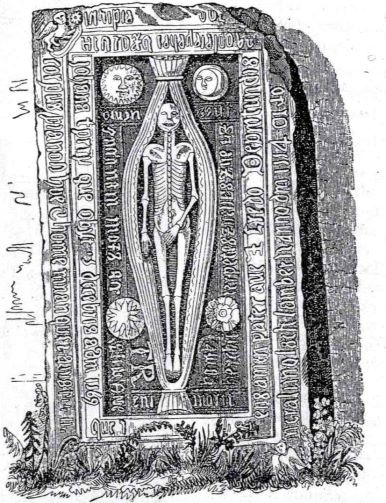
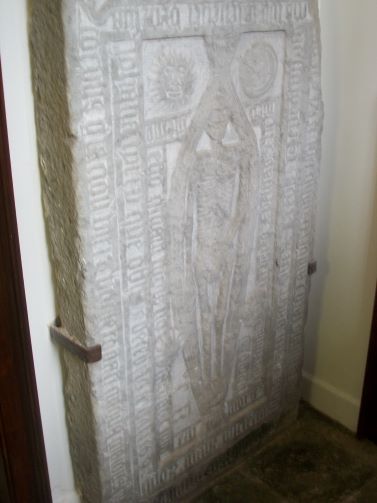
Answers are to be emailed to archaeology@corkcity.ie by 20th November. The winner will receive The Churches of Cork City – An Illustrated History by Antóin O Callaghan
Check in to the next instalment in our series on the 24th November when Ciara Brett, City Archaeologist and Niamh Daly will discuss Life and Death in Medieval Cork.
Welcome to the final part of the online series Knowledge Sharing: Cork’s Urban Heritage. In this edition we focus on the theme of Life and Death in Medieval and Post Medieval Cork.
In the first video presentation, Ciara Brett, City Archaeologist, examines the archaeological record and selected artefacts that are associated with the everyday lives of those who lived during the medieval period.
Niamh Daly, Consultant Osteoarchaeologist, then gives a short overview of plagues, epidemics and pandemics in Irish history drawing from the historical and archaeological sources.
Niamh will also provide a detailed examination of some of the skeletal remains uncovered from the excavations at Christchurch conducted by Dan Noonan Archaeological Consultancy in 2009. Case-studies include some common and unusual pathologies recorded associated with dental disease, habitual activities, metabolic disease, and incidences of antemortem trauma.
Dave Swift, from Claiomh Living History, has put together 2 interesting videos on Late Medieval Drinking Vessels and Medieval Archery. These videos were funded by the Heritage Council.
Book Competition
We are delighted to announce the winner of the October book competition:
Jessie Mc Donald will receive a copy of The Churches of Cork City – An Illustrated History by Antóin O Callaghan
October Answer: Christchurch
November Question:
To be in with a chance to win a copy of Cork in 50 Buildings by Kiernan McCarthy, can you answer the last question for this series book raffle which was kindly sponsored by the Cork City Library. Email the correct answer to archaeology@corkcity.ie by 11th December.
Question:
Can you identify the site where this Weaver’s Sword was unearthed during recent excavations in the city?
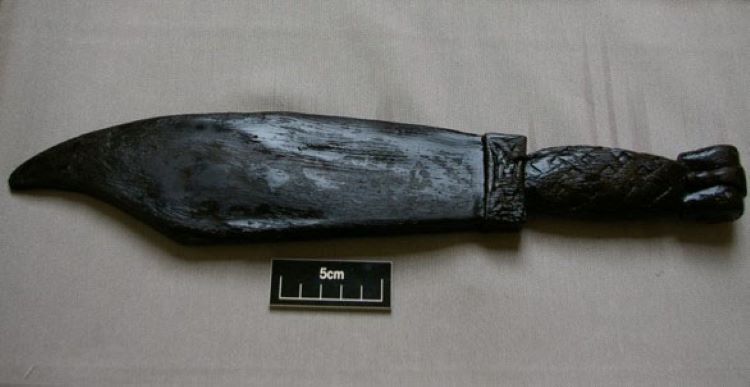
Derek Mahon, one of Ireland's leading poets died aged 78 on the 1st October 2020. Hewas born in Belfast in 1941, and lived in Kinsale, County Cork.
His beautifully reassuring poem Everything is going to be All Right brought comfort and solace to many during the first lockdown and now amidst the second lockdown he still reminds us all that "the sun rises in spite of everything".
Everything Is Going To Be Alright
How should I not be glad to contemplate
the clouds clearing beyond the dormer window
and a high tide reflected on the ceiling?
There will be dying, there will be dying,
but there is no need to go into that.
The poems flow from the hand unbidden
and the hidden source is the watchful heart.
The sun rises in spite of everything
and the far cities are beautiful and bright.
I lie here in a riot of sunlight
watching the day break and the clouds flying.
Everything is going to be all right.
As always, we will run the book raffle draw, but this year like everything, in a slightly different way. At the end of the information provided we will ask a question relating to Cork’s Urban Heritage. Answers are to be emailed to archaeology@corkcity.ie.